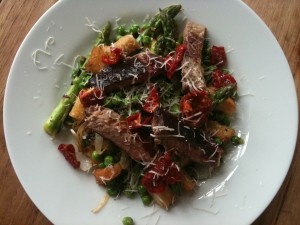 The lovely people over at Riverford sent over some goodies last week. They are trying to get us to eat less meat and more vegetables, which seems eminently sensible – good for the wallet, good for the gut, and good for the environment. Today’s lunch was a panzanella of sorts, in that it was a squidgy bread salad, though I added a few slices of sirloin from the Riverford meat box, and some heavenly oak-roasted tomatoes from The Garlic Farm on the Isle of Wight. You can order them online, but if your hunger is more pressing, just use any old sun-blushed tomatoes, or indeed fresh tomatoes. Or no tomatoes. But not tinned tomatoes. Or ketchup, you rascal.
The lovely people over at Riverford sent over some goodies last week. They are trying to get us to eat less meat and more vegetables, which seems eminently sensible – good for the wallet, good for the gut, and good for the environment. Today’s lunch was a panzanella of sorts, in that it was a squidgy bread salad, though I added a few slices of sirloin from the Riverford meat box, and some heavenly oak-roasted tomatoes from The Garlic Farm on the Isle of Wight. You can order them online, but if your hunger is more pressing, just use any old sun-blushed tomatoes, or indeed fresh tomatoes. Or no tomatoes. But not tinned tomatoes. Or ketchup, you rascal.
*****
Serves 1-2
A sirloin steak (optional, I suppose, though few things in recipes aren’t)
Half a dried red chilli, finely sliced
A spring onion, trimmed and sliced (green bits ‘n all)
A clove of garlic, sliced
A few chunks of stale white bread
A handful of peas
A few asparagus spears, trimmed and washed
A few oak-roasted tomatoes
Pecorino (to finish)
Olive oil, salt, pepper, lemon juice
– Rub the steak all over with salt, pepper, and olive oil, and get a saute pan dead hot. Slap in the meat and cook for 2 minutes on each side. Remove from the pan and rest.
– Add a generous slug of oil to the pan and sling in the chilli, onion, garlic, bread, peas and asparagus, season and stir fry for two minutes. Let the bread catch, here and there, so there are crisp bits and squidgy bits.
– Tip the contents of the pan onto a plate, slice the steak and lay on top. Finish with the tomatoes, a little grating of pecorino, and a squeeze of lemon juice. Eat.
How odd, I’ve been learning about this cheese recently due to coming across a very unusual fly. In Sardinia, the larvae of the cheese fly are intentionally introduced into Pecorino Sardo to produce a local delicacy called casu marzu.
Now this cheese fly is fascinating – ok well I think it is. The fly larvae can skip across the cheese. The larvae accomplish their jumps by bending over, grabbing onto their bums with their mouth hooks, tensing their muscles, and quickly releasing the grip. Spring action propels them into the air. One man in the 17th century described them as being able to jump 24x times the length of their body.
I wouldn’t eat the cheese if it had the live larvae in it though because they can survive the acid environment of the stomach and then bury their way through intestines.
For some reason, I’m no longer hungry.
How fascinating! One for Oliver Thring’s consider series I reckon